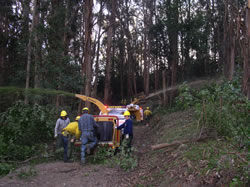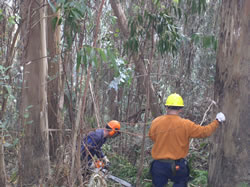
National Fire Plan Success Story
Recovery Act Fuel Reduction Creates Jobs, Improves Safety
San Francisco Bay Area National Parks, California
National Fire Plan, American Reinvestment and Recovery Act (ARRA) - Fuels Reduction
2010

Crews chipping slash from Recovery Act Fuel Reduction near Marin Drive in Golden Gate NRA.

Thinning a dense eucalyptus grove near homes in the wildland-urban interface.
In 2009-2010, S.F. Bay Area National Parks received funding from the American Reinvestment and Recovery Act to accomplish several high priority fuel reduction projects. This economic stimulus program required federal agencies to choose projects that addressed the highest priority mission needs, created the largest number of jobs in the shortest period, and created lasting value for the American public.
"We kept people working and we got a lot done. This was definitely a great opportunity," said Fuels Management Specialist Jordan Reeser who managed the projects.
Recovery Act Fuel Reduction Projects at Golden Gate National Recreation Area and Point Reyes National Seashore provided employment totaling 1,350 person days, and resulted in 325 tons of biomass utilization, primarily through exports to overseas markets. The ability to convert the non-native eucalyptus trees removed in this work to products such as paper pulp kept the total cost of the projects low, at only $310,000, by nearly eliminating the costs of hauling and debris disposal. In the meantime, these projects addressed the top two fire management goals for these parks of ensuring that firefighter and public safety is the highest priority for all fire management activities, and reducing wildland fire risk to private and public property.
The Recovery Act fuel reduction projects also supported critical fire management goals described in the Marin Community Wildfire Protection Plan (CWPP). This plan, developed by local government, emphasizes a 5-part strategy, which includes:
- A fuelbreak network of managed vegetation between public lands and developed areas. This plan includes treatment along national park boundaries to protect adjacent communities.
- Fire-prone forest clearing with an emphasis on non-native eucalyptus and Monterey pine, two major sources of hazardous fuel that threaten many communities in Marin. Areas of fire prone forest have also resulted from a growing Sudden Oak Death epidemic.
Recovery Act Fuel Reduction project sites were selected based on where fuel loads posed an especially high risk to private property and park infrastructure.
All of the project sites were on National Park Service land in Marin County, north of San Francisco, California. The Golden Gate sites were located at Wolfback Ridge, Marin Drive, Fort Barry and Upper Tam Valley. The Point Reyes sites were located at Bear Valley and Highway One, between Bolinas and Olema.
All sites received treatment except for Upper Tam Valley, where planning is still in progress. The main treatment involved thinning non-native eucalyptus groves by removing smaller trees, 18-inches in diameter or less. Work at the Bear Valley site also involved removing dead and diseased trees, primarily tanoak, live oak and other hardwoods, which resulted from Sudden Oak Death.
This program employed more than 40 workers over the course of 8 months. The workforce included wildland firefighters who had been laid off after fire season from both local and federal government crews, an Americorps work crew, and several professional arborists. The material cut by the crews was chipped or piled for burning later. Overall, approximately 175 acres were treated in a heavily populated wildland-urban interface, potentially affecting thousands of homes and lives.
Contact: Jennifer Chapman, Fire Communication and Education Specialist, (415) 464-5133.